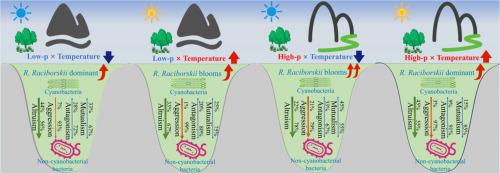当前位置:
X-MOL 学术
›
Water Res.
›
论文详情
Our official English website, www.x-mol.net, welcomes your
feedback! (Note: you will need to create a separate account there.)
The shifts in microbial interactions and gene expression caused by temperature and nutrient loading influence Raphidiopsis raciborskii blooms
Water Research ( IF 11.4 ) Pub Date : 2024-10-30 , DOI: 10.1016/j.watres.2024.122725 Baohai Zheng, Ling Zhou, Jinna Wang, Peichang Dong, Teng Zhao, Yuting Deng, Lirong Song, Junqiong Shi, Zhongxing Wu
Water Research ( IF 11.4 ) Pub Date : 2024-10-30 , DOI: 10.1016/j.watres.2024.122725 Baohai Zheng, Ling Zhou, Jinna Wang, Peichang Dong, Teng Zhao, Yuting Deng, Lirong Song, Junqiong Shi, Zhongxing Wu

|
Climate change and the trophic status of water bodies are important factors in global occurrence of cyanobacterial blooms. The aim of this study was to explore the cyanobacteria‒bacterial interactions that occur during Raphidiopsis raciborskii (R. raciborskii) blooms by conducting microcosm simulation experiments at different temperatures (20 °C and 30 °C) and with different phosphorus concentrations (0.01 mg/L and 1 mg/L) using an ecological model of microbial behavior and by analyzing microbial self-regulatory strategies using weighted gene coexpression network analysis (WGCNA). Three-way ANOVA revealed significant effects of temperature and phosphorus on the growth of R. raciborskii (P < 0.001). The results of a metagenomics-based analysis of bacterioplankton revealed that the synergistic effects of both climate and trophic changes increased the ability of R. raciborskii to compete with other cyanobacteria for dominance in the cyanobacterial community. The antagonistic effects of climate and nutrient changes favored the occurrence of R. raciborskii blooms, especially in eutrophic waters at approximately 20 °C. The species diversity and richness indices differed between the eutrophication treatment group at 20 °C and the other treatment groups. The symbiotic bacterioplankton network revealed the complexity and stability of the symbiotic bacterioplankton network during blooms and identified the roles of key species in the network. The study also revealed a complex pattern of interactions between cyanobacteria and non-cyanobacteria dominated by altruism, as well as the effects of different behavioral patterns on R. raciborskii bloom occurrence. Furthermore, this study revealed self-regulatory strategies that are used by microbes in response to the dual pressures of temperature and nutrient loading. These results provide important insights into the adaptation of microbial communities in freshwater ecosystems to environmental change and provide useful theoretical support for aquatic environmental management and ecological restoration efforts.
中文翻译:

温度和养分负荷引起的微生物相互作用和基因表达的变化影响 Raphidiopsis raciborskii 水华
气候变化和水体的营养状况是全球蓝藻水华发生的重要因素。本研究的目的是通过在不同温度(20 °C 和 30 °C)和不同磷浓度(0.01 mg/L 和 1 mg/L)下进行微观模拟实验,使用微生物行为的生态模型和加权基因共表达网络分析 (WGCNA) 分析微生物自我调节策略,探索在 Raphidiopsis raciborskii (R. raciborskii) 水华期间发生的蓝细菌与细菌相互作用。三向方差分析显示温度和磷对 R. raciborskii 生长的显著影响 (P < 0.001)。基于宏基因组学的浮游细菌分析结果表明,气候和营养变化的协同效应增加了 R. raciborskii 与其他蓝细菌争夺蓝藻群落主导地位的能力。气候和营养物变化的拮抗作用有利于 R. raciborskii 水华的发生,尤其是在大约 20 °C 的富营养化水域中。 20 °C 富营养化处理组与其他处理组的物种多样性和丰富度指数存在差异。共生浮游细菌网络揭示了水华期间共生浮游细菌网络的复杂性和稳定性,并确定了网络中关键物种的作用。该研究还揭示了以利他主义为主的蓝藻和非蓝藻之间复杂的相互作用模式,以及不同行为模式对 R. raciborskii 水华发生的影响。 此外,这项研究揭示了微生物用于响应温度和营养负荷双重压力的自我调节策略。这些结果为淡水生态系统中微生物群落对环境变化的适应提供了重要见解,并为水生环境管理和生态恢复工作提供了有用的理论支持。
更新日期:2024-10-30
中文翻译:

温度和养分负荷引起的微生物相互作用和基因表达的变化影响 Raphidiopsis raciborskii 水华
气候变化和水体的营养状况是全球蓝藻水华发生的重要因素。本研究的目的是通过在不同温度(20 °C 和 30 °C)和不同磷浓度(0.01 mg/L 和 1 mg/L)下进行微观模拟实验,使用微生物行为的生态模型和加权基因共表达网络分析 (WGCNA) 分析微生物自我调节策略,探索在 Raphidiopsis raciborskii (R. raciborskii) 水华期间发生的蓝细菌与细菌相互作用。三向方差分析显示温度和磷对 R. raciborskii 生长的显著影响 (P < 0.001)。基于宏基因组学的浮游细菌分析结果表明,气候和营养变化的协同效应增加了 R. raciborskii 与其他蓝细菌争夺蓝藻群落主导地位的能力。气候和营养物变化的拮抗作用有利于 R. raciborskii 水华的发生,尤其是在大约 20 °C 的富营养化水域中。 20 °C 富营养化处理组与其他处理组的物种多样性和丰富度指数存在差异。共生浮游细菌网络揭示了水华期间共生浮游细菌网络的复杂性和稳定性,并确定了网络中关键物种的作用。该研究还揭示了以利他主义为主的蓝藻和非蓝藻之间复杂的相互作用模式,以及不同行为模式对 R. raciborskii 水华发生的影响。 此外,这项研究揭示了微生物用于响应温度和营养负荷双重压力的自我调节策略。这些结果为淡水生态系统中微生物群落对环境变化的适应提供了重要见解,并为水生环境管理和生态恢复工作提供了有用的理论支持。


















































 京公网安备 11010802027423号
京公网安备 11010802027423号